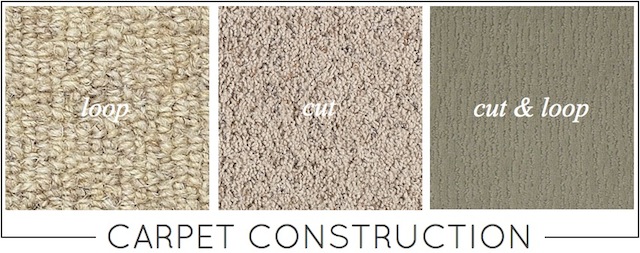GUIDE: SELECTING WALL TO WALL CARPET
Wall-to-wall carpeting provides insulation for both sound and temperature in a room. It is easy to clean and typically less expensive per square foot installed than wood or tile. When selecting carpet, think about where it'll be and how it'll be used. Near an outside door? Lots of traffic? Bright sunlight? Heavy furniture? Will it be exposed to food and drinks? Carpet prices can range from a few dollars a square yard to hundreds of dollars. You'll also need to add in the cost of installation and padding for an extra $6-20 a square yard. I recommend purchasing the highest quality pad you can, even if you go cheap on the carpet. It'll make your carpet last longer and feel much more luxurious.
FIBERS
Wool: Natural is best. Because of the lanolin in wool it is naturally stain resistant & flame retardant. Like area rugs, wool is easiest to clean. It can be dyed in any color and woven into any pattern. If it gets wet, it won't mildew. It will wear well over time, but is more expensive than synthetics.
Nylon: Nylon is the most popular of the synthetics. It is the most durable and it is resistant to being crushed by heavy furniture. Nylon fibers can be cut into a variety of carpet styles: shag, loop, cut pile, etc. Nylon's resistance to soil & sun is not as good as other synthetics.
Polypropylene/ Olefin: Solution-dyed acrylic. This is the same material they make outdoor fabrics from, it will not fade but has less bounce than nylon. Once you've worn that path from the sofa to the fridge it is not going away. It does have greater soil-resistance than nylon. The least-expensive of synthetics.
Polyester: Soil-, stain-, & fade-resistent, but not very resilient and durable. This is good in rooms without a lot of heavy furniture or if you plan on never redecorating. Very soft.
Triexta: The latest in carpet fibers, this combines the best of polyester & nylon in a polymer made from corn.
Natural fibers (sisal, jute, grass, bamboo): Because natural fibers are extremely hard to clean, I do not recommend installing this wall-to-wall.
>>TIP: Sometimes carpet manufacturers come up with proprietary names for the fibers above and market them as such, so even if it is called something else it is likely made from one of the above fibers.
CONSTRUCTION
Tufted: When the strands of yarn are punched through a backing by a machine and glued into place. This is the least expensive option and most common, though less durable. Yarn can be cut, loop, or cut/loop.
Woven: Creating a more stable and durable carpet, the yarns from the front & back are interlaced. Yarn can be cut, loop, or cut/loop.
Cut: The tips of the yarn is cut & exposed.
Loop: Yarn is woven into a loop. Loops can be the same level or at different lengths.
Cut & Loop: Includes both cut pile and loop - creating different patterns and designs.
>>TIP: The higher the pile of the carpet the softer, but the harder it is to clean.
Carpet density: Carpet is assigned a weight, which signifies how closely the yarn is packed together. The denser the carpet the more durable it is. Since there is more material in the denser carpet it is also more expensive.
>>TIP: Compare carefully, sometimes you'll be paying for a brand name rather than carpet quality.
EARTH-FRIENDLY
Carpet manufacturing is a dirty business. There are lots of chemicals in the synthetics and generally not good for the planet. However, there are some carpets that have Green label, some companies use recycled or renewable materials, and others will recycle used carpet. If this is important to you, there are an increasing amount of choices.


